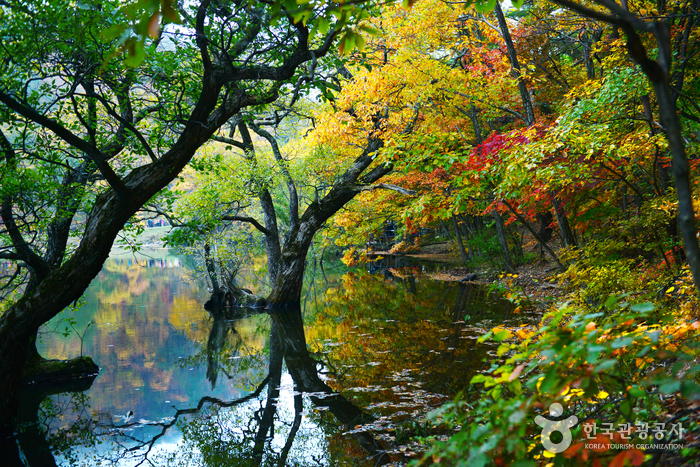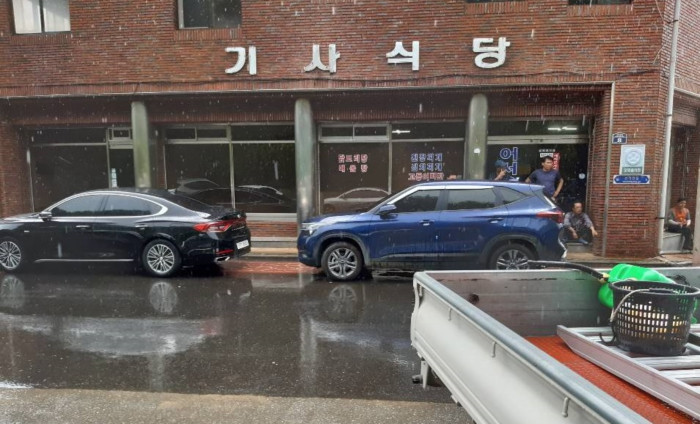Parc Unesco de la vallée Jeolgolgyegok à Cheongsong (절골계곡-청송 국가지질공원)절골협곡 (청송 국가지질공원)
15.1Km 2024-12-13
Gyeongsangbuk-do, Cheongsong-gun, Juwangsan-myeon, Jusanjiri, San124
+82-54-870-6111
La vallée Jeolgolgyegok se situe au sud-est du mont Juwangsan et se caractérise par son eau pure. Avec ses roches étonnantes et sa dense forêt, la vallée Jeolgolgyegok vous propose des randonnées pleines d'émerveillement.
A environ 1km de la vallée, vous trouverez le lac de Jusanji.
Etang Jusanji (주산지)
17.1Km 2024-12-13
Juwangsan-myeon, Cheongsong-gun, Gyeongsangbuk-do
+82-54-870-6111
Jusanji, situé dans le parc national de Juwangsan de hanjarak, désigne un petit lac niché entre des monts.
Il a été construit vers 1720. Pendant 300 ans, il a servi de réservoir d’eau pour les habitants aux alentours et pour l’irrigation de leurs champs. Le lac mesure environ 100 m de long, 50 m de large pour 7-8 m de profondeur. Malgré les différentes périodes de sècheresse, le lac a toujours su survivre aux différentes intempéries.
Dans les environs de Juwangsan, on trouve également une petite forêt dense alors que le lac est entouré notamment par une trentaine de saules d’une 150aine d’années.
Afin de mieux apprécier Jusanji, les saisons les plus belles sont le printemps et l’automne.
Aux alentours de Jusanji se trouve la route de Naejuwang, avec ses chemins tortueux et ses lieux très difficilement accessibles au fin fond de la montagne (les chemins de randonnées autour du lac en montagne sont régulièrement fermés au public) .
Le site du lac est également au centre du film du réalisateur Kim Ki-duk, « Printemps, été, automne, hiver et printemps ». Le fameux pavillon au centre du lac présent dans le film a été construit pour le tournage, il n'est plus visible sur le site.
Festival des légumes sauvages de Yeongyang (영양 산나물축제)
18.2Km 2024-04-25
37, Guncheong-gil, Yeongyang-eup, Yeongyang-gun, Gyeongsangbuk-do
054-680-6062
Le Festival des légumes sauvages de Yeongyang vise à célébrer la culture des légumes sauvages dans la région. Le festival vise notamment à mettre en valeur le légume 'sannamul' via diverses activités ludiques.
Suaedang [Korea Quality] / 안동 수애당 [한국관광 품질인증]
18.2Km 2023-04-13
1714-11, Sugogyonggye-ro Imdong-myeon, Andong-si, Gyeongsangbuk-do
+82-54-822-6661
'Suaedang Traditional House was built by Ryu Jin-geol, also known by his pen-name of Suae, in 1939. This hanok-style house consists of three buildings that measure 29-kan (a traditional measurement that corresponds to the space between two columns) in total.
The main room, or jeongchim (7-kan at front and 2-kan at sides), has a half-hipped roof, and forms a‘ㄱ’-shape with the storeroom (10-kan at front), which also has a half-hipped roof. Originally located at 612 Sugok-dong, Andong-si, the house was relocated from a slight slope to a flat piece of land due to the construction of Imha Dam in 1987. Consequently, the Jeongchim was rebuilt at a lower level than before.
The Suaedang was renovated by modernizing the old-style facilities including the kitchen, toilets, and washroom without changing their external features, while the rooms and daecheongmaru (main floored room) were decorated with red clay and natural paint. Suaedang, with its beautiful panoramic view of the lake, was designated as Gyeongsangbuk-do Cultural Property No. 56.
Imhaho Gisa Sikdang(임하호기사님식당)
19.0Km 2021-04-09
8, Seonchakjang-gil, Andong-si, Gyeongsangbuk-do
+82-54-822-4929
There are a variety of side dishes, so you can enjoy different foods. This Korean dishes restaurant is located in Andong-si, Gyeongsangbuk-do. The representative menu is kimchi stew.
Jeongjae Head House [Korea Quality] / 정재종택 [한국관광 품질인증]
19.0Km 2023-04-13
경상북도 안동시 임동면 경동로 2661-8
+82-10-8590-0625
Boasting more than 300 years of tradition, Jeongjae Traditional House is the head house of Ryu Chi-myeong (pen-name: Jeongjae), who inherited the study of Togye Yi Hwang (1501-1570), one of the two most prominent Korean Confucian scholars of Joseon. The old house features the characteristic construction elements of a Joseon hanok, including the stylobate, wooden pillars, toenmaru (the narrow wooden porch running along the outside of the building), tiled roof, and other structures, and commands an open view of Imha Lake. The house was originally built by Ryu Gwan-hyeon, the great-great-grandfather of Ryu Chi-myeong, in 1735 (the 11th year of the reign of King Yeongjo of Joseon) in the village of Handeul in Imdong-myeon, Andong-si, Gyeongsangbuk-do, but it was relocated to the foot of Guamsan Mountain in 1987 when Imha Dam was built and the surrounding area was submerged as a result. The house consists of the daemunchae (gate building), jeongchim (a ‘ㅁ’-shaped house with a tiled roof), haengnangchae (servants’ quarters), a shrine, and a pavilion. The sarangchae (men’s quarters) is clearly visible, while the anchae (women’s quarters) is concealed within the house. The sarangchae has a sarangmaru (wooden floor), a large sarangbang room, a small sarangbang room, and there is a small maru between the two rooms. The buildings of the sarangchae and anchae are clearly divided into segregated spaces for men and women according to Confucian tradition. The anchae has a daecheongmaru (large wooden floor) in the middle; a main room, kitchen, and toilet on the right; and a numaru (upper floor) and sangbang (upper room) on the left. The small side door of the main gate links to the door by which to enter the anchae, which has a small vegetable garden. Manujeong Pavilion (Gyeongsangbuk-do Cultural Heritage Material No. 37) is a half-hipped roof building with single-layered eaves located on the left side of the house outside the main gate. It is the place where Ryu Chi-myeong used to teach his students, and consists of a large maru and a guest room. The pavilion is also surrounded by the beautiful scenery of Imha Lake, mountains, and chestnut trees. Jeongjae Traditional House provides two special experience programs: Making Songhwaju, which is the Ryu family’s home-brewed liquor (15 to 18 degrees) made with rice, glutinous rice, yeast, pine needles, and chrysanthemums, led by the owner’s wife (Intangible Cultural Asset No. 20); and Making Tarak, which is a fermented milk drink that has been made by the Ryu’s family for some 500 years. As the recipe for making Tarak is relatively simple, and uses yeast that is usually used to make raw rice wine like Makgeolli, people can easily make it at home. The house also runs a traditional music program designed to show participants how to play the gayageum (Korean zither with twelve strings) and sing Korean folk songs, and stages small concerts.


![Suaedang [Korea Quality] / 안동 수애당 [한국관광 품질인증]](http://tong.visitkorea.or.kr/cms/resource/88/2528888_image2_1.jpg)

![Jeongjae Head House [Korea Quality] / 정재종택 [한국관광 품질인증]](http://tong.visitkorea.or.kr/cms/resource/96/2579496_image2_1.jpg)
 Français
Français
 한국어
한국어 English
English 日本語
日本語 中文(简体)
中文(简体) Deutsch
Deutsch Español
Español Русский
Русский